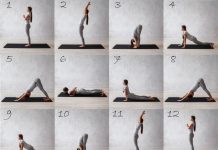Being present or in the moment is more relevant in today’s context than ever before. Given the busy life style, distractions and preoccupations that we deal with on a daily basis, people are in search of methods to be more present and less lost in thought. Being caught up in the constant cycle of thoughts causes stress, which brings its own string of health related problems. On the other hand, when we do yoga and meditation we are more present, healthy, calm, joyful and balanced. This is what we call as “well-being”.
Zen Yoga is a yoga practice which aims to create wellbeing by training the mind to be present. This is the basic tenet. However the practices are more geared towards liberation or “nirvana”. Here is a little history lesson on Zen Yoga. This style of yoga originated in Japan. Zen comes from the Sanskrit word “Dhyan” which means “to meditate.” During Buddha’s time, yoga and meditation became popular. A monk by the name of Bodhidharma took it to China where “dhyan” came to called as “chan”. With the passage of time, this style of meditation entered Japan and became known as “Zen”. It is believed that the word “Zen” was coined by Masahiro Oki.
Practicing Meditation or Dhyan or Zen is a way to becoming more Present. Many of us find it hard to sit with eyes closed even for a few minutes as the overbearing thought patterns overwhelm most people. That is where yoga comes into play. Yoga practices prepare the body and mind for meditation. Zen Yoga is a practice that emphasizes staying in the present and being mindful of it. This yoga is taught/practiced in certain Zen temples and includes physical yoga postures, movements that are more free and fluid like that of tai chi, and some repetitive exercises. These practices are designed to prepare the body for meditation, build a deeper mind body connection, enhance awareness of the body and cultivate mindfulness – all of which helps to stay in the present.
Zen yoga (unlike power yoga or acro yoga) developed in Japan as a method to elevate one’s consciousness. The spiritual component of stilling the mind to experience our true Self is the very essence of this practice. Therefore it incorporates elements of other practices like hatha yoga and tai chi to align the body and mind so that meditation can blossom naturally. Let’s look at the Zen yoga components and its purpose.
1) Physical practices: The physical part of the practice prepares one to sit with the spine erect and centered as in the zazen meditation. It is said that when the yogi finds the right sitting posture, the mind body and energy get aligned and enlightenment happens.
2) Energy flow: When the energy flows though the pathways unobstructed, it brings physical, mental and emotional wellbeing. The elevation of the energy and raising of one’s consciousness are inextricably connected. The Zen yoga practices guide the energy to flow in established pathways thus enhancing the consciousness levels of the yogi
3) Mindfulness: Mindfulness is a big part of Buddhist meditation and the Buddha is said to have practiced and taught mindfulness. Mindfulness meditation makes the mind calm and peaceful and paves the way for ultimate liberation. Zen Yoga practices heighten the awareness of any blocks and obstructions in the body. Non judgmental observation releases these blocks making the yogi increasingly free and flowing.
Whether the goal is of ultimate liberation or well-being Zen yoga practices set the proper foundation.
47 Most Famous Motivational Quotes of All-Time
49 Greatest Love Quotes
37 Inspirational Quotes that Will Change Your Life






























